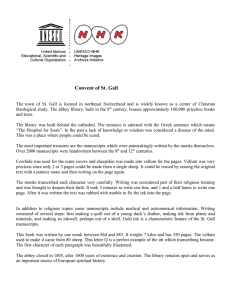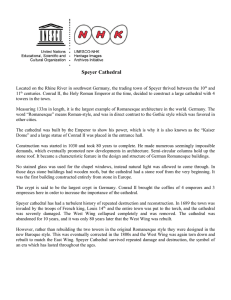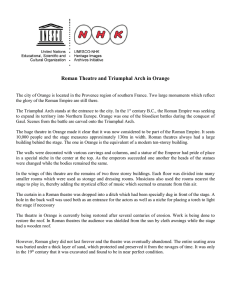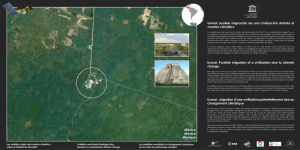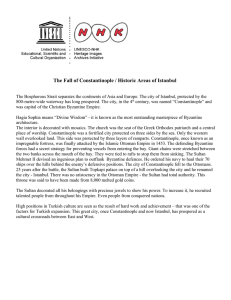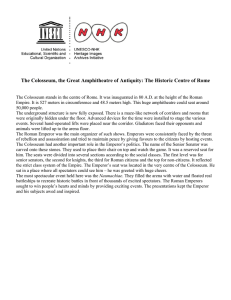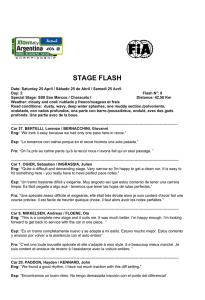Toxicologie et Pharmacologie: Études de Cas et Suivi Thérapeutique
Anuncio
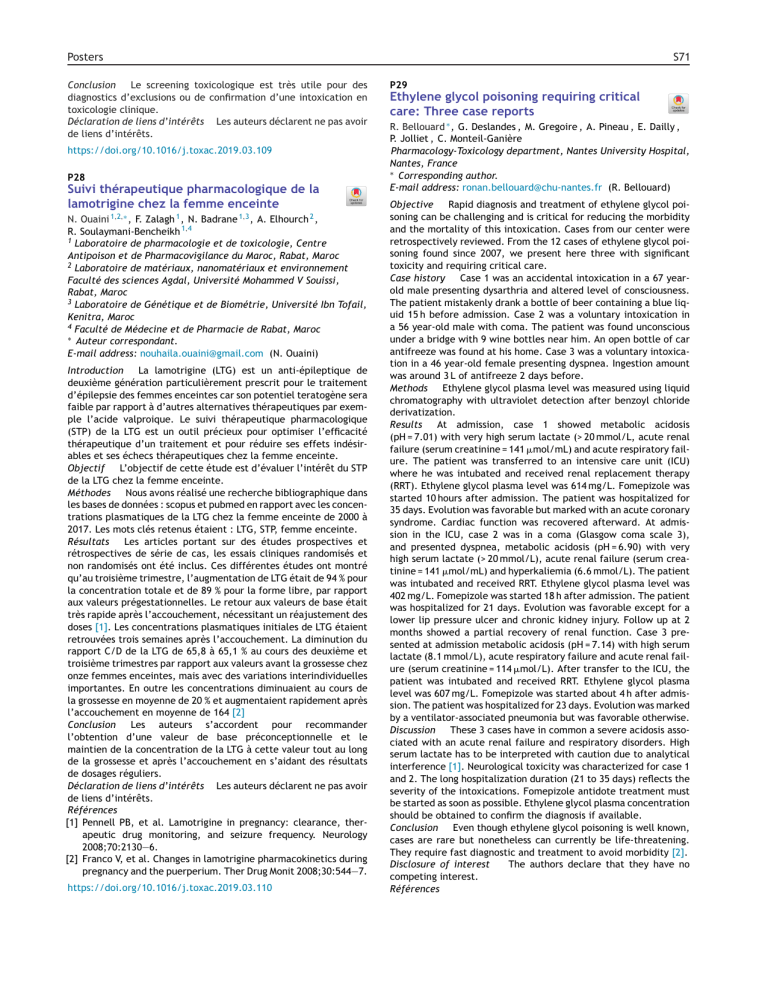
Posters Conclusion Le screening toxicologique est très utile pour des diagnostics d’exclusions ou de confirmation d’une intoxication en toxicologie clinique. Déclaration de liens d’intérêts Les auteurs déclarent ne pas avoir de liens d’intérêts. https://doi.org/10.1016/j.toxac.2019.03.109 P28 Suivi thérapeutique pharmacologique de la lamotrigine chez la femme enceinte N. Ouaini 1,2,∗ , F. Zalagh 1 , N. Badrane 1,3 , A. Elhourch 2 , R. Soulaymani-Bencheikh 1,4 1 Laboratoire de pharmacologie et de toxicologie, Centre Antipoison et de Pharmacovigilance du Maroc, Rabat, Maroc 2 Laboratoire de matériaux, nanomatériaux et environnement Faculté des sciences Agdal, Université Mohammed V Souissi, Rabat, Maroc 3 Laboratoire de Génétique et de Biométrie, Université Ibn Tofail, Kenitra, Maroc 4 Faculté de Médecine et de Pharmacie de Rabat, Maroc ∗ Auteur correspondant. E-mail address: [email protected] (N. Ouaini) Introduction La lamotrigine (LTG) est un anti-épileptique de deuxième génération particulièrement prescrit pour le traitement d’épilepsie des femmes enceintes car son potentiel teratogène sera faible par rapport à d’autres alternatives thérapeutiques par exemple l’acide valproique. Le suivi thérapeutique pharmacologique (STP) de la LTG est un outil précieux pour optimiser l’efficacité thérapeutique d’un traitement et pour réduire ses effets indésirables et ses échecs thérapeutiques chez la femme enceinte. Objectif L’objectif de cette étude est d’évaluer l’intérêt du STP de la LTG chez la femme enceinte. Méthodes Nous avons réalisé une recherche bibliographique dans les bases de données : scopus et pubmed en rapport avec les concentrations plasmatiques de la LTG chez la femme enceinte de 2000 à 2017. Les mots clés retenus étaient : LTG, STP, femme enceinte. Résultats Les articles portant sur des études prospectives et rétrospectives de série de cas, les essais cliniques randomisés et non randomisés ont été inclus. Ces différentes études ont montré qu’au troisième trimestre, l’augmentation de LTG était de 94 % pour la concentration totale et de 89 % pour la forme libre, par rapport aux valeurs prégestationnelles. Le retour aux valeurs de base était très rapide après l’accouchement, nécessitant un réajustement des doses [1]. Les concentrations plasmatiques initiales de LTG étaient retrouvées trois semaines après l’accouchement. La diminution du rapport C/D de la LTG de 65,8 à 65,1 % au cours des deuxième et troisième trimestres par rapport aux valeurs avant la grossesse chez onze femmes enceintes, mais avec des variations interindividuelles importantes. En outre les concentrations diminuaient au cours de la grossesse en moyenne de 20 % et augmentaient rapidement après l’accouchement en moyenne de 164 [2] Conclusion Les auteurs s’accordent pour recommander l’obtention d’une valeur de base préconceptionnelle et le maintien de la concentration de la LTG à cette valeur tout au long de la grossesse et après l’accouchement en s’aidant des résultats de dosages réguliers. Déclaration de liens d’intérêts Les auteurs déclarent ne pas avoir de liens d’intérêts. Références [1] Pennell PB, et al. Lamotrigine in pregnancy: clearance, therapeutic drug monitoring, and seizure frequency. Neurology 2008;70:2130—6. [2] Franco V, et al. Changes in lamotrigine pharmacokinetics during pregnancy and the puerperium. Ther Drug Monit 2008;30:544—7. https://doi.org/10.1016/j.toxac.2019.03.110 S71 P29 Ethylene glycol poisoning requiring critical care: Three case reports R. Bellouard ∗ , G. Deslandes , M. Gregoire , A. Pineau , E. Dailly , P. Jolliet , C. Monteil-Ganière Pharmacology-Toxicology department, Nantes University Hospital, Nantes, France ∗ Corresponding author. E-mail address: [email protected] (R. Bellouard) Objective Rapid diagnosis and treatment of ethylene glycol poisoning can be challenging and is critical for reducing the morbidity and the mortality of this intoxication. Cases from our center were retrospectively reviewed. From the 12 cases of ethylene glycol poisoning found since 2007, we present here three with significant toxicity and requiring critical care. Case history Case 1 was an accidental intoxication in a 67 yearold male presenting dysarthria and altered level of consciousness. The patient mistakenly drank a bottle of beer containing a blue liquid 15 h before admission. Case 2 was a voluntary intoxication in a 56 year-old male with coma. The patient was found unconscious under a bridge with 9 wine bottles near him. An open bottle of car antifreeze was found at his home. Case 3 was a voluntary intoxication in a 46 year-old female presenting dyspnea. Ingestion amount was around 3 L of antifreeze 2 days before. Methods Ethylene glycol plasma level was measured using liquid chromatography with ultraviolet detection after benzoyl chloride derivatization. Results At admission, case 1 showed metabolic acidosis (pH = 7.01) with very high serum lactate (> 20 mmol/L, acute renal failure (serum creatinine = 141 mol/mL) and acute respiratory failure. The patient was transferred to an intensive care unit (ICU) where he was intubated and received renal replacement therapy (RRT). Ethylene glycol plasma level was 614 mg/L. Fomepizole was started 10 hours after admission. The patient was hospitalized for 35 days. Evolution was favorable but marked with an acute coronary syndrome. Cardiac function was recovered afterward. At admission in the ICU, case 2 was in a coma (Glasgow coma scale 3), and presented dyspnea, metabolic acidosis (pH = 6.90) with very high serum lactate (> 20 mmol/L), acute renal failure (serum creatinine = 141 mol/mL) and hyperkaliemia (6.6 mmol/L). The patient was intubated and received RRT. Ethylene glycol plasma level was 402 mg/L. Fomepizole was started 18 h after admission. The patient was hospitalized for 21 days. Evolution was favorable except for a lower lip pressure ulcer and chronic kidney injury. Follow up at 2 months showed a partial recovery of renal function. Case 3 presented at admission metabolic acidosis (pH = 7.14) with high serum lactate (8.1 mmol/L), acute respiratory failure and acute renal failure (serum creatinine = 114 mol/L). After transfer to the ICU, the patient was intubated and received RRT. Ethylene glycol plasma level was 607 mg/L. Fomepizole was started about 4 h after admission. The patient was hospitalized for 23 days. Evolution was marked by a ventilator-associated pneumonia but was favorable otherwise. Discussion These 3 cases have in common a severe acidosis associated with an acute renal failure and respiratory disorders. High serum lactate has to be interpreted with caution due to analytical interference [1]. Neurological toxicity was characterized for case 1 and 2. The long hospitalization duration (21 to 35 days) reflects the severity of the intoxications. Fomepizole antidote treatment must be started as soon as possible. Ethylene glycol plasma concentration should be obtained to confirm the diagnosis if available. Conclusion Even though ethylene glycol poisoning is well known, cases are rare but nonetheless can currently be life-threatening. They require fast diagnostic and treatment to avoid morbidity [2]. Disclosure of interest The authors declare that they have no competing interest. Références S72 Joint Meeting SFTA — STC — SoHT — BLT 2019 [1] Graïne H, et al. Interference of ethylene glycol on lactate assays. Ann Biol Clin 2007;65:421—4. [2] Mégarbane B. Treatment of patients with ethylene glycol or methanol poisoning: focus on fomepizole. Open Access Emerg Med 2010;2:67—75. https://doi.org/10.1016/j.toxac.2019.03.111 P30 ® Diphoterine in therapeutic care of chemical burn: To recommend or not to recommend? G. Grenet ∗ , F. Peysselon , N. Paret , B. Kassaï , A.-M. Patat , K.-A. Nguyen , T. Vial Service de pharmacotoxicologie, Centre Antipoison de Lyon, Hospices civils de Lyon, Lyon, France ∗ Corresponding author. E-mail address: [email protected] (G. Grenet) Conclusion Compared to water or saline solution, the benefit of ® decontamination with diphoterine is questionable. We believe that the decontamination should be performed as early as possible with the most easily accessible solution, and water should be the first option. Disclosure of interest The authors declare that they have no competing interest. Références [1] Brent J. Water-based solutions are the best decontaminating fluids for dermal corrosive exposures: A mini review. Clin Toxicol 2013;51:731—6. [2] Alexander A, et al. Chemical burns: diphoterine untangled. Burns 2018;44:752—66. [3] Lynn DD, et al. The safety and efficacy of Diphoterine for ocular and cutaneous burns in humans. Cutan Ocul Toxicol 2017;36:185—92. https://doi.org/10.1016/j.toxac.2019.03.112 ® Objective Diphoterine (Prevor Company, France) is an amphoteric hypertonic solution proposed for decontamination in case of cutaneous or ocular corrosive injury. Our Poison Information Center of Lyon (PIC Lyon) is regularly questioned by occupational health professionals about the benefit of diphoterine® . As new studies became available since the last review of Brent [1], our aim was ® to assess systematically the available evidence on diphoterine . Methods Non clinical studies and randomized or non-randomized ® trials in humans assessing the benefit of diphoterine after cutaneous or ocular chemical burns were eligible. We searched Medline, Google and the Prevor website. After screening title and abstracts, relevant articles were selected, and the following data were extracted: study characteristics including quality assessment, type of controls and clinical outcomes (such as healing delay, burn severity), presence of potential conflict of interest. Results We identified 37 articles or abstracts of whom 12 original studies (6 sponsored by Prevor company) were included. Five controlled studies were conducted in animals (ocular exposures in three and skin in two). Sample size ranged from 16 to 30 animals. ® Two studies (one randomized) suggested an effect of diphoterine use on ocular pH but not on clinical outcomes; one randomized study suggested a decrease of corneal injury; one randomized study observed a complete or almost complete healing of the burn injury ® in the five rats treated with diphoterine compared to a detersion of eschar or a wound re-epithelization in the five rats treated with normal saline solution. However, these last studies reported multiple outcomes, without defining a principal, and did not correct for mul® tiple testing. The last study, assessing the safety of diphoterine , did not detect hypersensitivity reactions after skin exposure. Seven studies were conducted in humans with both eye and skin exposures. Sample size ranged from 5 to 180. Of the 3 retrospectives cases series, one uncontrolled study (24 subjects) did not detect ® adverse effects attributable to diphoterine decontamination; one uncontrolled study (34 subjects) suggested a decrease in pain; the controlled study (131 subjects) did not show a decrease in the ® time to healing as compared to water (9.0 days in the diphoterine ® group versus 7.0 in the non-diphoterine group, P = 0.258). Of the 4 prospective studies, one was uncontrolled (5 subjects) and 3 ® compared diphoterine to water and/or saline solution (from 65 to 180 subjects). Regarding the three controlled prospective trials, none of them were randomized; none of them controlled the alpha risk when reporting multiple outcomes; they suggested clinical benefits with less serious burns, decrease in pain or shorter time for recovery. Discussion We did not find acceptable level of evidence suggest® ing a clinical benefit of diphoterine . Observations reported in the prospective clinical trials were at high risk of bias and at high risk of false positive results. Our results are consistent with previous systematic review [1—3]. We did not assess the financial cost of ® diphoterine . P31 Sélection des étalons internes optimaux en ICP-MS avec un plan d’expérience factoriel T. Lanot 1,∗ , D. Metsu 1 , P. Gandia 1 , S. El Balkhi 2 Laboratoire de Pharmacocinétique et Toxicologie, CHU de Toulouse, France 2 Service de Pharmacologie, Toxicologie et Pharmacovigilance, CHU de Limoges, France ∗ Auteur correspondant. E-mail address: [email protected] (T. Lanot) 1 Objectif En spectrométrie de masse à plasma à couplage inductif (ICP-MS), la sélection d’un étalon interne (IS) est généralement basée sur la proximité de masse atomique [1,2]. L’efficacité de ce critère n’est généralement pas évaluée. Nous démontrons ici que l’utilisation d’un plan d’expériences factoriel, est l’approche la plus pertinente pour la sélection d’IS notamment dans des milieux biologiques. Méthodes Treize IS ont été considérés pour un panel de 28 analytes d’intérêt biologique (Tableau 1). Les essais ont été réalisés sur un NexIONTM 350D (Perkin-Elmer). Des échantillons, contenant les analytes et les IS, ont été préparés et dosés dans 324 différentes conditions instrumentales (CE), organisées selon un plan d’expériences factoriel complet à 6 facteurs. Ces facteurs sont des paramètres liés à l’instrument : débit de nébulisation, tension électrique du QID, puissance du plasma, mode d’élimination des interférences, et à l’échantillon : concentration en IS, matrice. Les variations de niveau de ces facteurs visent à mimer des CE dégradées. Pour chaque analyte, l’IS optimal est choisi selon sa capacité à suivre les variations de signal subies par l’analyte selon ces différentes CE. Résultats Pour chaque analyte, l’IS prédit par sa masse et l’IS optimal sélectionné sont dans le Tableau 1. La proximité de masse était à l’origine d’une sélection d’IS inadaptés notamment pour des éléments lourds (plomb, uranium, bismuth, thallium) ou pour l’oxyde d’arsenic, ce dernier étant mesuré afin de s’affranchir d’interférences spectrales sur le dosage de l’arsenic. Des essais réalisés sur des échantillons surchargés révèlent que la quantification de certains éléments avec l’IS prédit par la masse peut conduire à des résultats très insatisfaisants. Pour le baryum 138 en particulier, l’utilisation du cérium 140 comme IS aboutit à des concentrations mesurées 30 fois supérieures aux concentrations théoriques dans certaines CE. Conclusion L’utilisation d’un plan d’expériences factoriel est une approche de choix lors d’un développement de méthodes en ICP-MS et peut être appliqué à d’autres techniques analytiques. Déclaration de liens d’intérêts Les auteurs déclarent ne pas avoir de liens d’intérêts. Références

